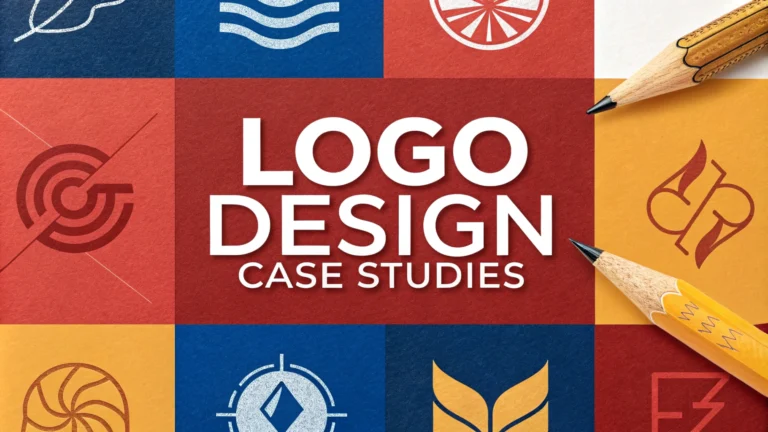Examining real-world logo design projects offers valuable insights into the creative process and problem-solving strategies used by professional designers.
Apple Logo Evolution
Apple’s iconic logo, designed by Rob Janoff in 1977, demonstrates how simplicity can create lasting brand recognition.
The initial rainbow-striped apple design represented the company’s first color-capable computer, while the modern monochrome version shows how logos can adapt to changing design trends.
- Original Cost: $50,000
- Time to Complete: 2 weeks
- Key Decision: Bite mark added to distinguish apple from cherry
Nike Swoosh Case Study
Carolyn Davidson created the Nike Swoosh in 1971 for just $35, proving that effective logos don’t always require massive budgets.
- Designer: Carolyn Davidson
- Original Brief: Create movement-suggesting symbol
- Development Time: 17.5 hours
- Impact: Estimated current brand value – $26.3 billion
FedEx Hidden Arrow
The FedEx logo, designed by Lindon Leader in 1994, showcases clever use of negative space with its hidden arrow between ‘E’ and ‘x’.
Design Process Highlights:
- Over 200 design variations created
- 400+ hours of development
- Won over 40 design awards
Key Learnings from Successful Logo Projects
- Start with thorough research and competitor analysis
- Create multiple concept variations
- Test designs across different applications
- Consider scalability from favicon to billboard size
- Document design rationale for client presentations
Common Budget Ranges for Logo Design
| Service Level | Price Range | Deliverables |
|---|---|---|
| Freelance Basic | $300-$1,000 | 2-3 concepts, basic files |
| Design Studio | $1,000-$5,000 | 5+ concepts, brand guidelines |
| Agency | $5,000-$50,000+ | Full brand identity system |
Project Timeline Example
- Discovery & Research: 1-2 weeks
- Concept Development: 1-2 weeks
- Refinement: 1 week
- Final Production: 1 week
Contact professional logo design organizations like AIGA (www.aiga.org) or Graphic Artists Guild (www.graphicartistsguild.org) for more case studies and resources.
Factors Affecting Logo Design Success
- Industry appropriateness
- Cultural sensitivity
- Technical feasibility
- Brand positioning
- Market differentiation
Logo Design Best Practices
Technical Considerations:
- Vector-based artwork
- Color variations (CMYK, RGB, Pantone)
- Minimum size requirements
- File format compatibility
Design Elements:
- Balance and proportion
- Visual hierarchy
- Typography selection
- Color psychology
Modern Logo Design Trends
- Responsive logos for digital platforms
- Minimalist approaches
- Dynamic identity systems
- Animation compatibility
- Social media optimization
Conclusion
Successful logo design requires a careful balance of creativity, strategic thinking, and technical expertise. The case studies of Apple, Nike, and FedEx demonstrate that memorable logos can emerge from various budgets and timeframes, but all share common elements of thoughtful conception and meticulous execution.
Whether working with a freelancer or a major agency, organizations must invest time in proper research, development, and testing to create logos that effectively represent their brand identity and stand the test of time.
As design technology and consumer preferences evolve, logos must maintain their core recognition while adapting to new media and applications. The most successful logos combine timeless design principles with contemporary execution methods.
FAQs
- What makes a successful logo case study?
A successful logo case study showcases the complete design process, including client brief, research, sketches, design iterations, color psychology, typography choices, and final implementation across various mediums. - How should logo design rationale be documented in case studies?
Logo design rationale should document strategic decisions, explain symbolic meanings, justify color selections, demonstrate versatility, and include client feedback and project outcomes. - What elements should be included in a logo design case study presentation?
Include project objectives, target audience analysis, competitive research, mood boards, concept development, design variations, final logo specifications, brand guidelines, and real-world applications. - How important is showing the evolution of logo concepts in case studies?
Showing concept evolution is crucial as it demonstrates problem-solving abilities, creative process, client collaboration, and how feedback shaped the final design. - What role do mockups play in logo design case studies?
Mockups demonstrate logo versatility across different applications, scales, and materials, helping visualize real-world implementation and brand consistency. - How should technical specifications be presented in logo case studies?
Technical specifications should include color codes (CMYK, RGB, Pantone), typography details, minimum size requirements, clear space rules, and file format information. - What makes before-and-after comparisons effective in logo case studies?
Effective before-and-after comparisons highlight improvements in brand recognition, scalability, versatility, and modern relevance while explaining strategic reasons for changes. - How should client feedback be incorporated into logo design case studies?
Client feedback should be presented to show collaborative process, design iterations, problem-solving approaches, and how specific requirements were met throughout the project. - What metrics can be included to demonstrate logo design success?
Include brand recognition improvements, audience response data, social media engagement, client testimonials, and any measurable business impact after implementation. - How should digital and print applications be balanced in case studies?
Case studies should demonstrate logo effectiveness across both digital platforms (websites, social media, apps) and print materials (business cards, signage, packaging) to show comprehensive versatility.








